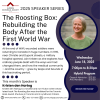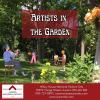Stuart, Jackie (2014) Transcript
November 29, 2014
Transcription: Jackie Stuart (JS), interviewed by Heba Shahaed (HS)
HS: My name is Heba, and I am here to interview Jackie Stuart at the Hollandview Trail Retirement Centre on November the 29th, 2014. Hi Jackie.
JS: Oh it’s very good to be here, thank you for asking me.
HS: So, how long have you lived in Aurora?
JS: Well, I’ve only lived here since 1984, but I began working here in 1980 and the job seemed to keep me here most of the time, so sometimes I feel that I’ve lived here since 1980.
HS: Wow, so where do you work?
JS: Well, I work at the Aurora Museum, which no longer exists, at least not quite in the same format. I hope by the time this film is seen by somebody there will be a new Aurora Museum, but the Aurora Historical Society operated the Aurora Museum and I was it’s first paid staff member, and so that’s where I worked.
HS: So is that what brought you to Aurora, the job?
JS: Absolutely yes, yes, with a little bit of something else. I mean first of all it was the job, but a bonus was that my father was born here in town and grew up here, so even though I really didn’t know Aurora at all, I felt as though I had second hand roots here. The job was great, that was the number one thing, but to have that family connection as well really, well that made it a perfect place for me.
HS: Sorry (for coughing). So what inspired you to work at Aurora Historical Society?
JS: Are you prepared for a long story? In my first career I worked in special libraries, that is not, not public libraries, not academic libraries, but libraries attached to businesses. In fact, I usually worked for civil engineers. I have no engineering background, no scientific background at all. So it came to a point where I was wanting to be involved with something, you might say, where I knew what was going on. You know I could provide people with information of all sorts, about engineering, building bridges or whatever; but I really didn’t know how to do it. So I was, I don’t know, maybe having a bit of a midlife crisis or something, a little bit early, and so I was looking for a second career. One day in, one summer of 1979 I guess, I went on a walking tour in downtown Toronto and I really enjoyed it. Masses of people, must’ve been three hundred people on the tour. So well organized, it was great. Got home, said to my sister, “wouldn’t it be wonderful to earn a living doing that sort of thing.” Ten minutes later she phones me and says, “have you seen an advertisement for a course being offered at Seneca College in historical/natural interpretation?” No, well to cut a long story just a little bit shorter, but the end of the summer I was enrolled in that course at Seneca, given up my first career. So spent two years at Seneca, learning about eighteen hundred different sorts of ferns which, I can’t remember one of those things now, but also about talking to people about historical buildings, histories of places, and so on, doing the interpretation part mainly, but also about running small museums in particular. And so when I finished that course, that coincided with the opening up of this job in Aurora. One of the co-directors of the course was John McIntyre, who happened to have spent all his life in Aurora and be very active in the Aurora Historical Society. So everything fell into place and I took that job, and I’ve been here ever since.
HS: Wow.
JS: I can’t remember what your question was, but anyway.
HS: Oh I think you definitely answered it.
JS: I just rambled on.
HS: So how long have you been at the Aurora Historical Society?
JS: Well it seemed like a good idea to join the historical society if they were going to employ me, seemed like the polite thing to do, so I joined the society I guess, in 1980, I didn’t, I actually worked for the society and the town combined in 19- during the summer of 1980, but I didn’t actually begin working at the museum until 1981, but I join the society in 1980.
HS: And you still work there or no?
JS: No, I retired back in 2006, there were big changes coming and I was a couple of years early, I was 63 I guess, so I could’ve worked another couple of years, but as I say, there were changes anticipated, as it turned out not the changes we’d been looking to, but. So it seemed a good time to leave, also my mother happened to be quite ill and needed assistance at home, but let a new person come in who could see the museum through all those changes. As I say, didn’t quite work out that way, but that was why I retired then.
HS: I see, so what do you, what do you think are like, some very interesting stories about Aurora?
JS: Oh,
HS: During your time here.
JS: During my time, gosh, well I guess like anyone who’s lived in Aurora for more that about ten years, sort of the number one thing that comes to your mind I think is it’s grown so much. So even in that time, which may seem like a long time to a young person, but to me doesn’t seem all that long since 1980, Aurora has grown so much. But of course the history is still there, and everyday that goes by a little bit more history is being added, you know history doesn’t have to be a hundred years ago, it can be yesterday. It’s all part of the big story. I’m not sure that I can think of any one great, big thing that happened during that time that, you know ask my twenty four hours from now and maybe I will have thought of it, but right now I can’t think of any one big thing that happened during that time. I’m sorry.
HS: Oh that’s okay, do you, maybe like, what was the biggest change in Aurora since you came here?
JS: Well, I guess the growth certainly, and I remember once talking to somebody, a neighbour of mine at the time, and referring to, I think it was Connaught, a street named Connaught, which is on the east side of Yonge, and this person who had lived in Aurora for twenty years, I think, didn’t know where Connaught was. I was thinking to myself, that’s shameful, how can you live in the town and not know where this street is. Today, put me east of Bayview, I don’t know any of the streets over there. I might know some of the names, but I don’t know where they are, and I think that’s true for a lot of people in Aurora now. You know, there are so many new parts of town that, if you have no occasion to go there, if you don’t have friends there or whatever, you might not know. And those areas of town too, tend to be largely residential, or commercial. So you know all the umpteen plazas along Bayview, and then on either side, lots of housing. If you’re going to a store you don’t need to go through the housing and vice versa. So, the fact that there are great big chunks of town that I don’t know is a regret to me, I’m not sure what I can do about it, except drive up and down, up and down, memorizing street names or something. But that certainly is a change, but again it’s just reflective of the huge growth of Aurora over those years.
HS: I believe like, Aurora was very small before. So is there like a certain place that you like to go to, or maybe a restaurant?
JS: A hangout sort of, no, not especially. I mean something that in one way hasn’t changed and in another has, is the public library. Still in the centre of town, although here we are in 2014 and there are little whispers and maybes and little bits of chit chat about perhaps opening up another branch of the library, but as it is, new library building, certainly replacing what was here when I first came to town, but still in the centre of town. And that is definitely a favourite place of mine, not that I go and sit there in the comfy chairs and so on, but just go you know and get to know the staff and spent a lot of time reading old Aurora Banners on the microfilm or digitized versions, but I have been known to kind of pinch myself to wake up if I’m looking for something, it just goes by and by on the screen. But I still see the library as the, even though it’s in a new building, very much a, as a, one of the hearts of town anyway. You do see people there and I’m always so pleased, especially on a weekend if I go in and the place is packed with people, all ages. Sadly I think not, not all using printed matter, you know, all using computers and their own gadgets of one sort or another and so on, and obviously some people are students working on together. It’s, it’s just so great to see this, the library being so heavily used even in this high-tech age. So, I’m not sure that’s quite the sort of place you meant in your question, but that’s an important place.
HS: Oh no, totally yea. So was like, the library very important for lots of people?
JS: Oh I think so.
HS: Yeah?
JS: I think so. It could be these days that a fairly small proportion of people actually borrow books. I’m not sure of that, I could, I could believe that. But of course you can get your, your e-reader book now, through the library and get it all on your own device and that sort of thing. And people use all the electronic databases that are available through the library. Some of those you can use from home. It’s a, I think public libraries in general probably are to be congratulated in how well they’ve kept pace with the changing times and needs and technology and so on, to go on providing wonderful service. And they’re not paying me anything to say this, it’s true.
HS: Were there like, many schools in Aurora when you were here?
JS: There were already quite a few schools, certainly, in Aurora, but quite a number added since then. Not only in the public and catholic school systems, but private, privately operated schools as well. At one point there seemed to be a Montessori school about every other block, I think that number has been rationalized a bit now, and of course, the oldest of out private schools: St. Andrew’s College, going back a very long way, back to the 1920s. It’s own history goes father back than that, but in Aurora it’s the 1920s. And at the, at the old days at the museum, this is being, as you said at the beginning this is being taped in November, and by now we would’ve started our Christmas programs for the schools at the museum so, kids would come either from walking, a few schools within walking distance of the museum, which I should say was in, what I still think of as Church Street School, is currently the Aurora Cultural Centre on Church Street, so that’s where the museum was, on the second floor. So by this time of year we would be very busy with schools visits for special Christmas programs.
HS: Was there something that the children loved to see in the museum? Like something that interested them?
JS: Well, don’t tell anyone this alright? This is confidential but, it was not so much for the children, or adults for that matter. Well no, we’ll stick to the children. Not so much seeing the old things, but getting involved in any activities which were enjoyable to them, but which secretly informed them of things that went on in the past. And then when they saw the old things somehow brought into those activities, then they really enjoyed it I think. Coming in and walking around and just looking at the old stuff is not enough, as every museum knows, you have to get, you have to excite peoples, whatever the age, you have to excite their interest in some other way as well.
HS: I know that you said you came here 1980 and that your father was also here, did you also start your family in Aurora?
JS: I have no family, my family is all of Aurora. No, I’m not married, have no children, and I’ve been known to say, sometimes the teachers would say to me “Oh, you’re so good with the kids,” and I’d be thinking, I’d say thank you, but I’d be thinking, “but I know they’re going to be gone in an hour, so it doesn’t matter how rotten they are.” Most were not of course, most were delightful children.
HS: Did you have siblings?
JS: I did, I have a sister who, very kindly is, we share a house and she’s kindly allowing us to go on living in Aurora because Aurora is so close to my heart, I mean it’s close to hers as well, but it’s really for me. I have brothers but they never lived in Aurora.
HS: So are there any stories of, about Aurora that you’ve learned while working at the Aurora Historical Society? Or at the museum?
JS: Well, a great many, of course can I think of any really, really fascinating ones right now? I suppose that it’s, we often think of people first, well okay interesting people, who have lived here. None. No that’s not true, of course interesting people have lived here. Going, well thinking back not all that far in two ways. We’re doing this at the very end of November, back on Remembrance Day a few people mentioned a man called Lloyd Chadburn, a young fellow, lived in Aurora, grew up in Toronto and Oshawa, but came to Aurora as a high school student, I think, was not academically inclined. Went off to Oshawa I think, to work on cars for a while, but his, his mother lived here and she operated a tourist home which is, today would be called a bed and breakfast, on Yonge Street, very fine old house. Anyway, Lloyd Chadburn, once the Second World War began, signed up to join the air-force and became a top-notch pilot and became known across Canada, the fact that he was extremely good-looking did not hurt the fact that he became really well known. And it seemed that whenever he came home on leave, which wasn’t all that often, he was sent off by the government to go across the country, raising funds, people could buy Savings Bonds to help the war effort, he’d be off touring, doing that and so on. And not long before the end of the war he was killed in a, in a flying accident. It seems it wasn’t actually in battle in the air, it was an accident, which was, well it doesn’t matter how he died, it’s still extremely unfortunate of course, he was only one of thousands and thousands. But that’s one interesting person. He was a charmer for sure.
Other interesting people, well the historical society now is really based in Hillary House, and a lot has been written about the first owner of Hillary House, Dr. Geikie who became an extremely well known, not so much a physician but as administrator and teacher of young doctors, medical, at medical school. A lot has been written about the first Dr. Hillary to live there and his son, the second Dr. Hillary, and the Hillary family, but the second person to live there, so between Dr. Geikie and Dr. Hillary, Dr. Strange. Since I’ve retired I’ve done a lot of, a huge amount of research into his life, because nobody had written about it. Well, one day I’ll go into a print, into print about the wild and wooly life of Dr. Strange; lady-killer. One of his obituaries said: “his domestic life was very unorthodox.” So I’ll just leave that hanging about Dr. Strange, strange life.
Other interesting things, and another interesting person, thinking how I often say to myself or to others, “I know more people in the Aurora Cemetery than I do walking alive around the streets.” And there’s one very distinctive, we there’s several, but one of the distinctive markers in the Aurora Cemetary is that who is marking the grave of a man called John Bowser, or Jack Bowser as he was often known, and his grave marker is in the shape of the Empire State Building in New York City, because he was the Superintendent of Construction of that very famous building when it was built back in the late 1920s, the early 1930s. Brought the job in under budget and on time, and for his pains I think was given a silver tea service, just what every man needs of course, lovely tray and all the bits and pieces and stuff. He was paid for the job, but I often wish I knew if he got an actual cash bonus for doing his job so well, which I’m sure he would’ve appreciated more than the silver tea service. Now that tea service was given to the historical society for the museum, everything in the museum went to the town, but I have my doubts that that service was the one given to him, cause it’s not engraved. Sorry, I’m rattling on here.
HS: Oh no, that’s totally fine.
JS: But, John, oh sorry he, he was born in Aurora, more or less where Sir Max School, I mean St. Max School is, St. Maximilian Kolbe School is now, little house there. Ran away when he was eleven years old to seek fame and fortune, or because, who knows what, but he ran away and landed on his feet, got involved in the construction business, eventually down into the States and worked elsewhere in the world though, and was employed by the firm that constructed the Empire State Building. As I say he did other things too, and eventually came back to Aurora and temporarily took over the business of his brother-in-law, a man called Browning, who was ill. While Mr. Browning never did take over, take the business back, John Bowser went on with it, became the Aurora Building Company and he’s built houses, and shops, and factories, and so on, all over Aurora and Newmarket, and, as well as the Empire State Building. So, quite a, quite a story behind that one monument in the, in the cemetery. And not everyone would notice that it is shaped; and it’s just to scale, it’s very precise; like the Empire State Building, but once they know that, “why? Why here in Aurora?” And that’s the story.
HS: Wow,
JS: Other people though, or events, I mean there’s some events that Aurora enjoyed or suffered, depending on the nature of the event, that most small town’s have, and sometimes they’ve had the same impact in every small tow. For instance I’m thinking, in the past especially, but goodness knows it can happen today as well, there were a number of very serious fires on Yonge Street. The worst was in the 1880s when pretty well all of the west side of the business side of Yonge Street, that is from Wellington down to, to Tyler Street was burned out. Terrible loss, no one was killed, thank goodness, but a terrible loss to the people who owned the buildings, people who rented buildings for their shops, people who lived up above the shops, and so on. And many a town had that sort of fire in the days of wooden buildings. Even a brick building will burn if the, if the roof collapses; but in Aurora, as in other towns, that lead to the construction of a proper water system, so it was easier to fight fires, didn’t have to get water out of big tanks that were being let down into the street, covered up with boards. You know you had a more or less constant flow of water, and that happened in many other towns, and of course that water supply was not just for fighting fires, usually it was for providing water in people’s homes, businesses, so on. So that’s, that was a huge event in Aurora’s past and one that was shared by many places, in fact there used to be listings in the Toronto papers about fires in the province, and there’d always be a few listed.
Other big events, before I retired, but when I knew I was going to retired I kept a list, an actual written list; the things I wanted to spend more time finding out, whether it was people, or some little question, why does this street have a jog in it or whatever. And practically the day after I did retire I began looking up things on that list, and I guess usually I could find the answers, oh this is good, and I recorded the answer and took it and filed it away cause I was still doing some volunteer work in the museum even after I retired. But you know, this isn’t very interesting to other people, but there were some questions I couldn’t answer and will never be able to answer unless we get very lucky. These are big questions that, you know we, we talk about the first settlers in Aurora, and we know their names and we know little bits and pieces about them, but we don’t know what was going on in their heads. Were they thinking, “oh thank goodness I’ve got a fairly cheap farm and it’s going to take me forever to clear it,” and so and so on, or “I’ve got my piece of land now,” or “I’ve got my fairly cheap farm, I’m going to clear just enough, and then I’m going to sell it at mass profit and I’m going to move on to another place, cause I’m a frontier type guy.” But for the people who stayed, were they people who were thinking, “Gosh, we’re the beginning of a new town here, and some day people will look back on us as the founders of this place.” Which wasn’t even called Aurora back then, at that point. Or were they just going from day to day, “Oh good, at last we have a post office,” “Oh good, now we have two general stores that we can from,” you know, and I suspect that that was the case, they just did, did their work on their farm or wherever they worked, however they earned a living, but I’d like to be in the minds of those pioneers.
HS: Sure, yea.
JS: Another big, big question, not. There’s a, a well known person in Aurora’s early days by the name of Richard, and I’ll just spell his surname, M-A-C-H-E-L-L, there’s a street named after him in Aurora that’s parallel with Yonge, one block west of Yonge, running north from Wellington. Some people who live on that street call it Machell, some people call it Ma-Machell, some family members call it Machell, all these things. I want to know how Richard Machell, that’s how I always say it, I want to know how Richard Machell pronounced his name. At one point he owned three of the four corners of Yonge and Wellington, so not surprisingly the town had the unofficial of Machell’s, or Machell’s, or Machell’s, or whatever, Corners. And he was the reeve of the, well then, village council, which is a bit like being mayor, at least a couple of times. He had a big, important general store at the south east corner of Yonge and Wellington, so he was an important man in town, and I want to know how HE pronounced his name. Now I know people, cause I sent off a letter to all the people in the telephone directory for the little village in Yorkshire in England, where he came from, who had the same surname and I said, how do you pronounce your surname? And they all said to rhyme with the woman’s name of Rachel, so Machell, so, oh good, I’ll stick with that one, but I know not everyone does. And he had a plan of subdivisions subdividing some of his property up into smaller building lots, and the surveyor put on the plan Match, like M-A-T-C-H, Matchville, so I’m thinking maybe he actually said Machell and that the surveyor just misspelled it. I don’t know. So that’s one of the big questions, but not really.
I’d like to know what Aurora’s first school looked like, we have no pictures of the first school, we don’t even have pictures of the school which immediately preceded the, Church Street School, as well call it now, on Church Street which was built in 1886, or finished in 1886. There was a brick school there before that, we have no pictures of that.
Very sadly in 2014 we lost the Aurora United Church building by a horrible, horrible fire. Now there is something good, well bad, but there is a big event since I’ve lived here, a very recent one. Anyway, so that, that church building was erected 1873, 1874, something like that. We have no picture of the previous building. We have one picture that shows the entrance with the Sunday school class sitting on the steps and you can see the front door and about a foot all the way around the door, and that’s it. And you feel sure that somewhere out there there are photographs, even going back that far, there are pictures. But yes, thinking about that United Church fire in April of 2014, horrible event, and that I think drew the town together in a kind of sad way in a way. I remember it was a lovely day, a lovely April morning after a really bad winter, people were out, you didn’t have to put on your boots cause there was no snow or ice on the ground, it was fairly mild, and the word got round. Somebody phoned me and said “United Church is on fire,” I said, no, it’ll just be some little thing in the back, and went out onto Yonge Street, I just live off of Yonge and a couple blocks south of the site of the church and the street was crowded with people and many of them had no connection to the United Church but were feeling heart-broken just to see this very old landmark in town just burn away. Every effort of course was made to save it, but there came a point when you knew it was not going to be saved. There was a bit standing by the end of that day, but word soon came out that it wasn’t stable and the whole thing would have to be torn down. So, that was a terrible day, and I know fifty years from now people will look back and say “Oh yeah, that must’ve been bad,” turn the page, move on to the next thing. But for the people who were, even people like me who have no connection to that church, were standing there watching, it was horrible.
HS: Yeah, especially cause it’s been in Aurora for so long.
JS: That’s right, and people said at the time, “well the church is not the building, it’s the people, it’s the belief,” and so on, and so on. Which is all true, but the building’s important too. Maybe I can think of something happy I’m sure I can.
HS: I know the Christmas Parade always happened every year in Aurora, so when you came here like, did it go then as well?
JS: It did, although when I first came here in the 1980s I think it was, it was a big event, popular event and so on, but I think and, it’s history went back a while. If you go back to, I guess it was pre-World War One even, yes, pre-World War One.
HS: Oh wow
JS: No, not a Christmas, or Santa Claus Parade in Aurora, but what used to be called Eaton’s Santa Claus Parade. Now of course today even the Timothy Eaton’s Store, T. Eaton Store, means nothing to younger people, but it was a huge department store, like Hudson’s Bay Company, or whatever today, in downtown Toronto and family owned, Eaton family of course, and they started the Santa Claus Parade. I’m not sure where it began, maybe in Newmarket. Took two days, they went all the way down Yonge Street to Toronto, had to stop over night cause it was all on foot.
HS: Wow
JS: Had real reindeer, and people on the floats you know, throwing out goodies to the kiddies, candy and so on. Course now children wouldn’t be allowed to eat that candy that came from goodness knows where, even though it was wrapped. So that, that was a huge event and went through Aurora. Well then they stopped doing that was crazy, they did a much shorter parade, just in the city of Toronto. So I’m not sure actually, when the Aurora Santa Claus Parade was started, maybe in the fifties, 1950s. So it was, it was popular, but when I came to Aurora in the 1980s it was still very popular. But I think what really gave it a big boost was deciding to have it at night. It just added that certain something, of course you had floats lighted up and so on, that, that was really a, that was, that was a good move and I think has paid off well.
And thinking of seeing that parade on Yonge Street reminds me of something else, a very kind of commercial moment in a way, nothing much to do with the historical society or the museum except that it’s all part of Aurora’s history of course, and that was the first of the street sales, held in, whenever it’s held, May? June? I can’t even think. So sponsored by the Aurora Chamber of Commerce and both sides of the street from, well nowadays, I think it’s from Wellington down to, maybe to Murray. So people setting up their booths, selling this that, or talking about this and so on. That first sale, to be standing in the middle of Yonge Street, and no cars, and the street absolutely packed with people that whole distance, that was quite a moment. I mean it continues to be amazing, a really successful event, but that first event, and I cannot, off the top of my head remember when it was, I’m thinking maybe, late-ish 1990s but that was a big event and continues to be.
END.














